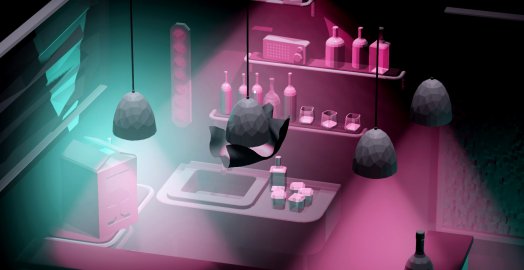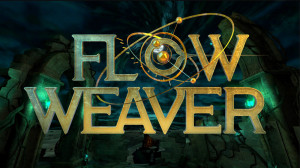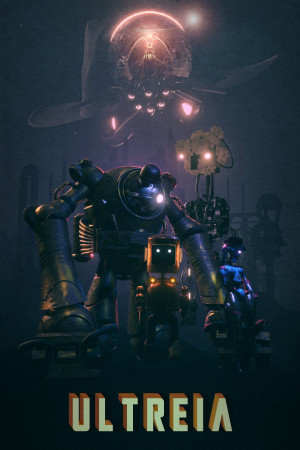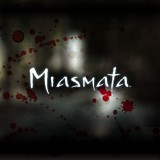Review for Hadr

When a magician picks your card from a seemingly shuffled deck, or pulls back a cloth to reveal the dove that was there just seconds ago has vanished, we accept these as tricks and not actual magic. Nevertheless, the craft of sleight of hand is impressive, and despite the fact that it’s not really sorcery, the illusion is no less entertaining. In Hadr, players assume the role not of a magician but of one of his tools: a cloth, which when draped over objects can make them disappear. This cloth, however, is different from others in the trade, as it does in fact make things go away, and even seems to be acting with its own motive. Though the gameplay is disappointingly limited, the concept is a clever one to explore while it lasts. The storybook narrative is enough to hook you, and getting to the bottom of the trick ultimately saves the experience from feeling too redundant.
Hadr consists of a number of discrete levels played from an isometric perspective. Using the keyboard, the Space bar lifts the cloth into the air while WASD moves it around the environment. Letting go of the former will cause the cloth to fall naturally back towards the ground, with some impressive cloth physics folding and wrinkling the fabric as it floats through the air and impacts objects. A “best played with a controller” warning prompts every time you boot the game up, and after trying with a keyboard my first time through, I can confirm that it does feel a bit more natural using the left stick to move and right trigger to ascend, though the difference is mostly negligible.
Judging the cloth’s height from an angle can prove tricky at first and can take some getting used to. As you navigate it around scenes of washrooms, cocktail bars, and more, you’ll need to watch its shadow in order to best gauge where it will land or collide with something. Some levels are just a single room, while others require you to drift both horizontally and vertically, exploring your surroundings, with the camera panning to follow as you reach the screen edges. If you get too close to a room’s invisible border (connoted by a blurring of the screen), you can trigger a level restart, which seems artificial but is a handy way to keep you on the intended path in some of the larger environments.
It feels intuitive enough to manipulate the cloth over an object, as you can guide its direction as it wraps around or rests on top of your intended target in order to better cover it, but getting the cloth to stay put on certain surfaces can be trying as it slips off easily. That’s not to say the cloth should be stickier (yuck), just that you’re subject to the laws of physics, and a mere cloth offers little resistance. It is possible to get the cloth stuck underneath an object, in which case you’ll be forced to manually restart the level. Each stage is short, however, and this risk of becoming trapped provides a welcome little bit of danger, making you think about how you want to tackle any given room.
Your main objective in each level is to find an escape hatch of some sort that will lead to the next room. In order to do this, you’ll need to make certain things disappear to either reveal an opening directly or trigger one to appear simply by vanishing enough objects that the game signals the exit by way of light and/or sound cue. Early on, you’ll simply be draping the cloth over books in order to uncover a hole in the floor. Later you’ll be floating through a train car, making luggage vanish into thin air before the car’s windows open up, allowing you to escape. The link between your “magical” ability and accessing the exit isn’t always apparent, but the goal never changes: make stuff go poof and eventually you’ll find your way out.
At times Hadr feels less like a puzzle game and more like a leisurely flight simulator, with your only task being to land on different objects and cover them completely. But while the levels start out quite basic, and a bit aimless in concept, there are a few memorable sequences later on. Some stages incorporate multiple cloths, allowing you to easily switch between them. You may need to alternate between two different parts of a scene, or use the extra surface area of two cloths together to cover larger objects, like couch cushions, leading to a delicate game of draping. Several scenes mix in specific environmental manipulation, such as making a series of dresser drawers disappear in a certain order (lest they reappear), or referring to a set of pictographs on a wall nearby a series of manhole covers. Still, few of the game’s challenges could be considered serious puzzles, and it seems like a missed opportunity not to have played with such a fun concept in more creative, brainteasing ways.
A slightly more complex scenario in an art studio features multiple canvases, each showing a different part of the same series of pipes, although all but two are blank at first. Once your cloth is positioned close enough to a canvas with an image, you can then switch to another cloth within the artwork and control it the same way, like an interactive picture-in-picture. Once that scene is emptied of its required elements and you reach the exit, it will trigger the next canvas to activate, prompting you to move the primary cloth to a better vantage point to continue. You’ll repeat this same process for each painting in order to complete the level. Within the artworks you’ll need to avoid having your cloths fall into “pits” of a sort, which will force a restart at the beginning of that sequence. I found it interesting to alternate between the studio and its canvases, keeping the game feeling lively as I chased the action across frames.
In between levels, you’ll be greeted with short blocks of text conveying the story of a magician performing a trick with his rabbit. The trick begins routinely enough, with the magician blanketing the caged rabbit and then pulling the cloth back to reveal that it has disappeared. But as the tale continues and the rabbit does not reappear, the magician's plight begins to tie into that of the cloth you control. The level décor and architecture play a role in this narrative as well, though it is a bit cryptic to unravel. In my first playthrough I didn’t find the link between the environments and story to be overtly evident, and I can’t say my second illuminated things much more, as the connection is kept purposely mysterious. I was intrigued to keep looking for clues regarding the rabbit’s fate, however, and finding out what happened proved a nice incentive to continue, ultimately leading to a satisfying conclusion.
Hadr utilizes a low-poly graphic style, and the clean, simple 3D constructions stand out thanks to the clever use of light and shadow to provide depth. There is seldom any movement in the backgrounds other than the occasional flashing light, running water, or receding floor tile (beckoning you to the next area), making the cloth’s reactive folds and flutters as it drifts and wraps around different objects the constant centre of attention. Environments start out sparsely populated with household things like bottles, vases, and even an adorable bunny rabbit, but they gradually become more complex and crowded as the game progresses. The rooms are not just carelessly packed with stuff to absorb, however, as the thoughtful composition of objects lends each setting a sense of meaning, with scattered or tipped-over furniture communicating the occupant’s temperament or emotional state. These smartly staged scenes make it feel as though you’ve arrived just after an incident – or happen to be in an alternate reality while they are transpiring.
The game is scored by a downtempo electronica soundtrack that suits the clean art design nicely, unobtrusively providing enough ambience to keep your mind on the task at hand and the pace relaxed. There are no time limits, and level restarts are hardily punishing, making the whole experience feel tranquil. Thanks to the short level lengths and interesting musical arrangements, the soundtrack never gets repetitive. One scene cleverly integrates its audio by cutting off the music if you cover the stereo system, while another has you removing the lamps in a bar lounge, cutting short the clinking of glasses and murmured chit chat in the sudden absence of light. Ambient noise is limited, the only notable effect being the slight hum produced when objects vanish. But since cloths aren’t really known for making loud noises, the quiet is perfectly appropriate.
At about an hour long, Hadr doesn’t require much time or effort to finish once you’ve learned to effectively pilot the cloth, though there’s a bit of a learning curve to reach that point. It’s a shame the disappearing-object mechanic isn’t used more inventively, as it seems primed for some clever Portal-style puzzles that could have added welcome depth and increased the challenge (and therefore play time) significantly. The subtle connective narrative thread won’t be to everyone’s taste, as this is the type of game that needs to be played multiple times in order to pick up on everything the story has to offer, yet the gameplay itself offers little variation to make replays more worthwhile. Ultimately, Hadr has a clever concept with a smart aesthetic, though it’s so short and underdeveloped that it’s hard not come away lamenting what could have been.


_capsule_fog__medium.png)












__medium.jpg)











